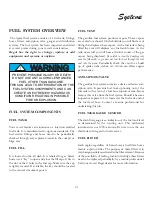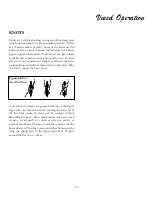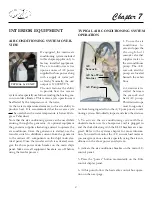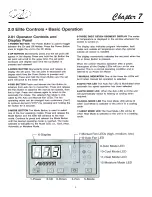
6
Chapter 6
DOCK LINE BASICS
Most skippers use dock line
terminology fairly loose but there is
more to the basics than just bow or
stern lines. There are several lines
that can be secured to the bow and
stern and depending on their
direction and use, can be called other
names. Remember that “forward”
and “aft” refer to the direction that a spring line runs from
the vessel, and not where it is secured on board.
BOW & STERN LINES
There is only one true bow line. It is secured to the forward
cleat and run forward along the dock to prevent the vessel
from moving to the stern. The stern line leads from a rear
cleat to a piling or cleat on the dock astern of the vessel.
This line keeps the boat from moving ahead. For small
vessels these are the only lines needed for normal wind
and current conditions. If located in a tidal environment,
keep slack in the lines.
BREAST LINES
These lines are attached to the bow and stern that lead to
nearly right angles from the center of the vessel to the
dock. They help keep larger vessels from moving away
from the dock, or are pulled in to help people board the
vessel. Bigger vessels may use bow or quarter breast lines.
SPRING LINES
Select boats use two spring lines although it is possible
to have four. They are called the after bow spring, and
forward quarter spring cleats.
Bow springs are secured at the vessels’ bow area. Forward
spring lines lead forward from the boat to the dock and
control movement sternward. After springs stem aft from
the vessel, and stop movement ahead. Spring lines are used
to prevent movement in a berth, ahead or astern. They are
really useful in controlling the effects of a real active tidal
surge. Spring lines are useful where fenders need to be
kept in place against piles.
1. Bow line
2. After bow spring
3.Forward quarter spring
4. Stern line
TYPICAL PIER MOORING
=FENDER
1.
2.
TYPICAL PILING MOORING
BOAT MOORING
Most boats can be secured to a dock using four lines. The
after bow spring is crossed with the forward quarter spring
and secured to individual dock cleats or pilings. This ensures
longer springs and can be snugged up tighter for more
efficient tidal control. Remember, if you only have one piling
available, position the vessel so this point is opposite
admidships. Run both spring lines to it. These lines will be
shorter but still useful.
3.
4.
Summary of Contents for 30 EXPRESS
Page 1: ...30 EXPRESS OWNER S MANUAL...
Page 2: ...784022 OWNER S MANUAL 30 EXPRESS 12 2012...
Page 30: ...11 Safety On Board NAVIGATION LIGHT RULES...
Page 41: ...Chapter 2 22 Notes...
Page 44: ...3 Rules Of The Road NAVIGATION RULES...
Page 85: ...28 Chapter 5 Notes...
Page 105: ...4 Chapter 7...
Page 106: ...5 Equipment Operation...
Page 107: ...6 Chapter 7...
Page 108: ...7 Equipment Operation...
Page 109: ...8 Chapter 7...
Page 110: ...9 Equipment Operation...
Page 111: ...10 Chapter 7...
Page 117: ...16 Chapter 7...
Page 126: ...25 Equipment Operation ROTARY ENCODER AND MENU KEY...
Page 127: ...26 Chapter 7 USING THE ROTARY ENCODER AND MENU KEY...
Page 158: ...57 Equipment Operation BACKING A TRAILER 1 2 3 4 LAUNCHING RAMP...
Page 161: ...60 Chapter 7 Notes...
Page 195: ...34 Chapter 8 Notes...
Page 204: ...9 Troubleshooting TOILET SYSTEM DIAGNOSTIC CHART...
Page 209: ...14 Chapter 9...
Page 219: ...6 Chapter 11 Notes...
Page 221: ...2 Chapter 12...
Page 224: ...5 Technical Information 30 Express Deck Overview 30 Express Cabin Overview...
Page 225: ...Technical Information 12 6 30 EXPRESS...
Page 226: ...12 7 Technical Information 30 EXPRESS...
Page 227: ...Technical Information 12 8 30 EXPRESS...
Page 228: ...12 9 Technical Information 30 EXPRESS...
Page 229: ...Technical Information 12 10 30 EXPRESS 30 EXPRESS...
Page 230: ...12 11 Technical Information TYPICAL NEGATIVE GROUND SYSTEM...
Page 231: ...Technical Information 12 12 30 EXPRESS...
Page 232: ...12 13 Technical Information 30 EXPRESS...
















































